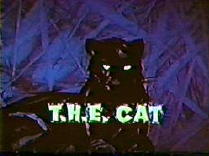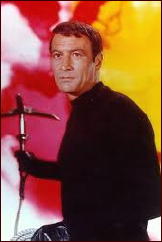BETWEEN THE COMMERCIALS –
T. H. E. CAT AND THE THIRTY MINUTE DRAMA
by Michael Shonk
Before you begin, may I suggest you read my earlier review of T.H.E. Cat here.
Since the sixty-minute drama became common in the 1960s, it has become rare for a half-hour drama to be successful on prime-time TV. Today the thirty-minute drama has virtually vanished from television.
I decided to take one of my favorite TV series T.H.E. Cat and examine how it worked and how it didn’t due to its thirty-minute format. Would adding a half-hour to each episode have made the series a success?

Airing in the TV season of 1966-67, the series was a rating failure in a way that made the audience rejection clear. T.H.E. Cat aired on NBC, Friday at 9:30-10pm. It followed rating success Man from U.N.C.L.E. With the last half hour of U.N.C.L.E. beating the first half hour of ABC’s hour long Milton Berle and competitive with CBS’s Friday Night Movie, one would expect the audience not watching the movie to stay with NBC’s T.H.E. Cat. Instead much of the audience changed channel to the movie on CBS and to a lesser extent ABC’s Milton Berle.
Chicago Tribune (September 17,1966) critic Clay Gowran liked the series citing “the spectacular photography, dramatic change of pace, and the human talent…†He also believed many would be upset by the “bloody action and the bizarre plots.â€
Later (October 31,1966) Gowran would interview star Robert Loggia who was on a publicity tour for the series. Gowran expressed his surprise that there had been no complaints about the violence. Loggia claimed that was because of how the violence was visualized and the “bizarre quality of the show.â€

One can argue that the failure of T.H.E. Cat was not due to its episodes’ length but to the series surreal world. This may explain the series ratings failure but what about creatively? What worked and what didn’t and could it have been fixed with more time per episode?
One of the things that worked best for the series was the opening. There was no time to slowly introduce the hero or the story of the week. Instead episodes began with an action scene. At the end of the short scene someone would ask Thomas who he was. In the style of the famous “Bond, James Bond,†Cat would reply, “Cat. T. Hewitt Edward Cat.†One of the best TV intros ever would follow featuring exciting animated titles with a great jazz theme written by Lalo Schifrin.
Arguably, the most successful form of drama for the thirty-minute TV series is the morality play. A good example of this is the episode “Crossing At Destino Bay.â€
Special note: this is one of the few T.H.E. Cat episodes where some of the color remains. The series color consultant Alex Quiroga would be disappointed to learn that the quality is so poor in most of the surviving prints that the color has usually vanished.
“Crossing At Destino Bay.†Written by Robert E. Thompson. Directed by Boris Sagal. Guest Cast: Robert Duvall, Fred Beir and Suzanne Cramer. *** Hired to protect a man he has yet to meet, Thomas finds Scorpio a paid killer holding four people, including Thomas’ client, hostage. They are waiting for Scorpio’s client to arrive and tell the assassin which one of the four to kill.
https://www.youtube.com/watch?v=66hmHB1T12c
This is a morality play, so it is no surprise that all four of the characters held hostage have reason to fear, each guilty of his or her own sin. The adulterer couple, the killer, and the embezzler who had associates hire Thomas, all are trapped not just by the killer but their own fears and guilt as well.
As all wait to learn who will die, killer Scorpio’s attention turns to Thomas. Duvall plays Scorpio with an odd soft-spoken accent and pride in his professionalism. He sees Thomas as his equal and knows one of them will not survive.
This is one of director’s Boris Sagal’s best works, as he takes the stylized dialogue and heavy symbolism of this virtual stage play and makes it visually interesting. Thompson’s script with one great twist is another plus for the episode. Thompson wisely sets the action in the waiting area for the Destino Bay ferry, a place where people escape from one side to the other, but now it is a prison for the characters surrounded by walls and an iron gate.
More time would have weakened the story, exposing the logic flaws and plot holes. Realism had no place here — expanding the mystery, developing the characters or the story would have just distracted from the story’s point.
Another way to create a successful story for the short format is with a simple plot and stock characters. The episode “The Sandman†did this well.
“The Sandman.†Written by James D. Buchanan and Ronald Austin. Directed by Boris Sagal. Guest Cast: Signe Hasso, Lee Bergere and Dennis Patrick *** Once the world’s greatest thief and mentor to Cat, a man known as The Sandman has returned for one last crime. A return to his first crime where he stole a famous jewel, now he plans to steal it back and return it to the museum he had stole it from many years ago.
https://www.youtube.com/watch?v=rnEe448qrqg
Hour long series such as Perry Mason would spend a great deal of time introducing the mystery and characters. But by using standard characters such as the great old thief in the tradition of Cary Grant in To Catch a Thief, the patient forgiving lover, and Thomas as the old thief’s former student, the audience fills in the blanks reducing the need for exposition.
While at times dull, series such as Perry Mason used the extra time it had to give the story a more interesting complex mystery, its characters more depth, and showed us exposition rather than having the characters artificially tell us.
Set in such a strange world T.H.E. Cat entertained through its unique style. Yet sometimes an episode needed more. In “Payment Overdue†there are too many characters, too many story lines, to fit in just thirty minutes.
“Payment Overdue.†Written by Robert Hamner. Directed by Boris Sagal. Guest Cast: Laura Devon, Paul Stewart, and Dean Harens. *** Why does the Mob want press agent Arnie Bliss dead? Arnie wishes he knew.
https://www.youtube.com/watch?v=C59UoH_HjQA
The plot of Arnie and the Mob could have filled the thirty minutes without adding the subplot of the relationship between Arnie and his client Jerri the singer working at Casa del Gato that week. The backstory of the singer and her guilt about her past was wasted, and it distracted from the central plot.
Worse, the viewer was left half satisfied, wanting to know more about the Mob that used a mortuary as a front, more about loser Arnie, more about the relationship between Arnie and the singer, and more about the life of the regretful singer. This is a story that would work well in today’s modern sixty-minute drama with a main plot and subplot.
So why has the thirty-minute drama vanished from television? Ignoring the commercial reasons, the longer hour series offers an easier path to better drama. There is more time to develop the characters, not only the guest characters of the week but the regulars as well.
One of the appeals of the weekly series are the regular characters who become like friends, people we want to spend time with every week, people we want to learn more about. In these times of long story arc and an audience that care about continuity, it is difficult for the half-hour series to find the time to satisfy those needs and still tell a story. It is not that it is impossible for the thirty-minute series to entertain us it is just easier for the hour-long episode to tell a story and satisfy the audience other needs.
If I were to pick one TV series I think should be remade it would be T.H.E. Cat. Its style and bizarre world would fit in well with today’s popular series of fantasy, strange mysteries and superheroes. More importantly an hour long weekly episodic series would have the time to develop Thomas and his world, a world where I would have liked to spend more time.

